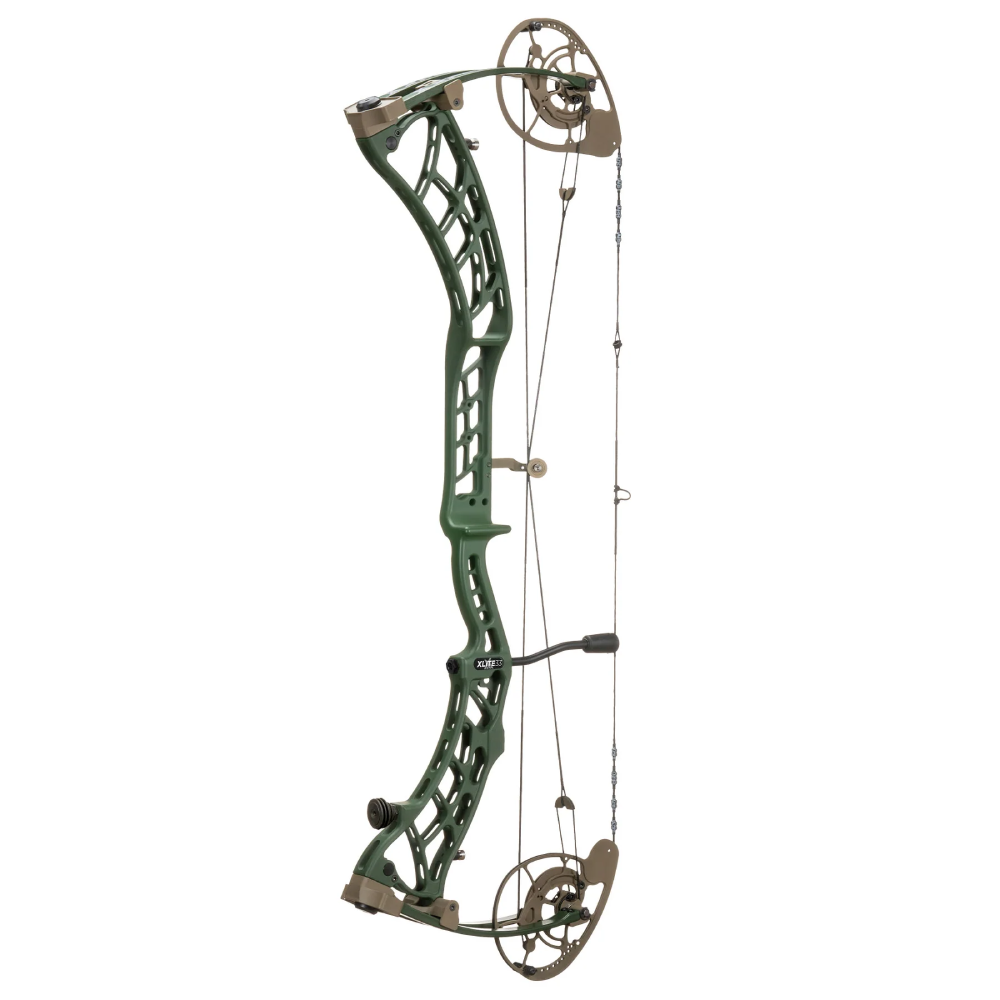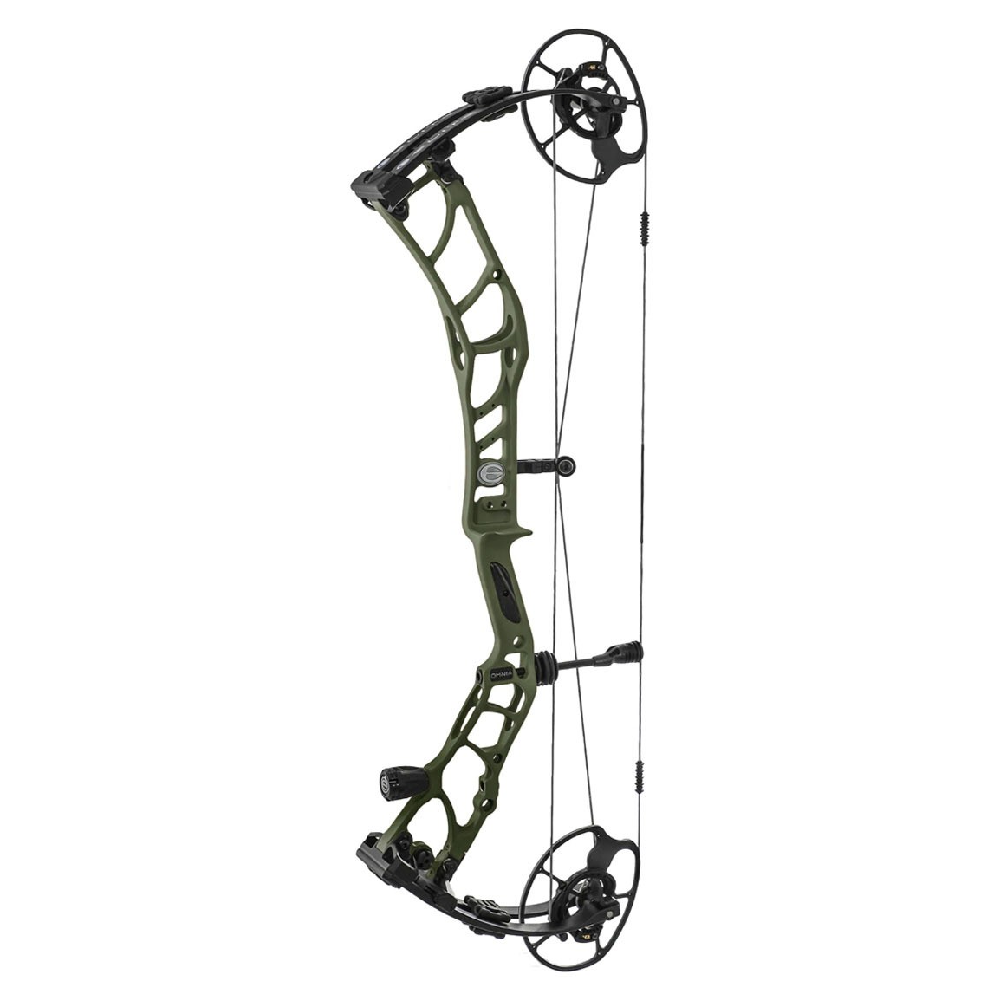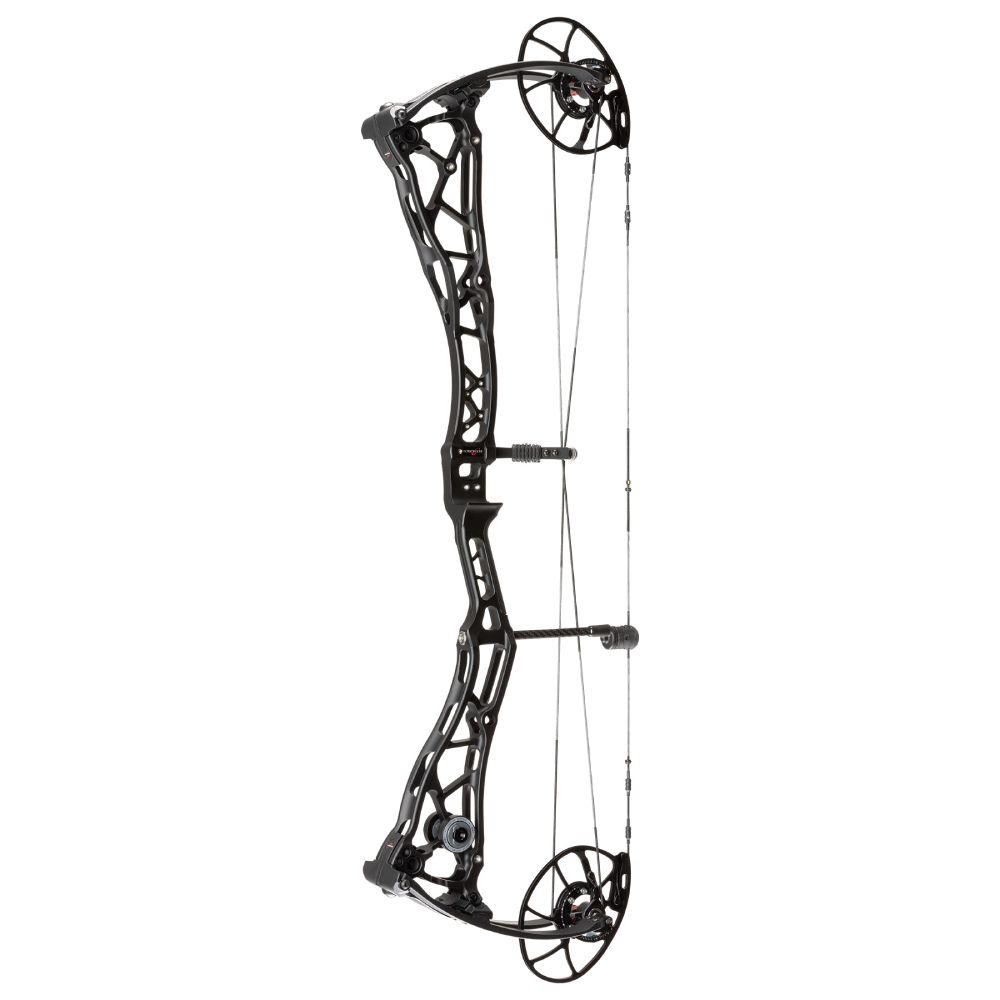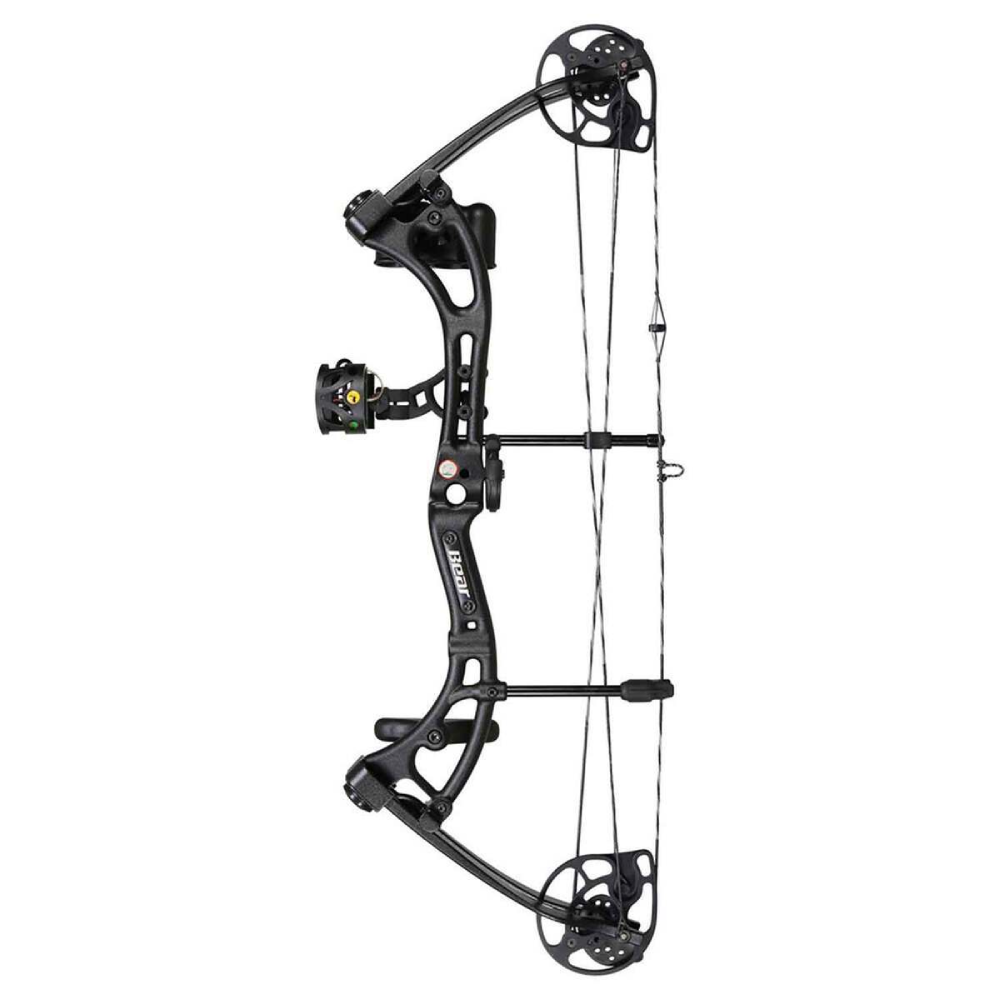We may earn revenue from the products available on this page and participate in affiliate programs. Learn more
Left handed compound bows are much easier to find today than they were 15 years ago. Many brands—like Hoyt, Mathews, and Bowtech—have started building lefty models of every new bow introduced, which is a great thing, and long overdue. It allows everyone to enjoy the insane speeds, accuracy, and reduced noise modern compounds have to offer. There’s really is no better time to be a lefty bowhunting because of it.
With that in mind, if you’re in the market for a new bow this year, look no further. Because we rounded up the best left handed compound bows you can buy, including the best for hunting—all ready ready to smoke that big buck come the fall seasons.
Best Overall: Xpedition Xlite 33
Best Draw Cycle: Bowtech SS34
Best Budget: Elite Omnia
Best for Youth: Bear Archery Cruzer G2
Best for Beginners: PSE Stinger Max
Best Overall: Xpedition XLite 33
Specs
Length: 33”
Weight: 5 lbs 4 oz
Draw Weights: 50, 60, 65, and 70 lbs
Draw Lengths: 26” – 31”
Speed: 292 fps
Pros
Transitions well from field points to broadheads
Produced sub-1-inch groups
Extremely quiet
Cons
Not the fastest bow out there
Some vibration
Brantley’s team scored the Xpedition XLite scored a 96 out of a possible 100 points, soaring far above the rest in almost every category (aside from noise and vibration). It was especially a winner in accuracy, as Brantley did Robin Hood an arrow during the tests and it was the only bow that produced sub-1-inch average groups. It also transitions perfectly from field points to broadheads without requiring additional testing and tuning.
The 33 in the name refers both to the 33-inch axle to axle length, and the proprietary alloy construction. Xpedition says the bow is 33 percent stronger than carbon or aluminum. Fortunately, this strength and durability doesn’t affect the bow’s weight at just 5 pounds, 4 ounces. Add in some quality limbs and cams, and you’ve got a complete winning package.
Best Draw Cycle: Bowtech SS34
Specs
Length: 34”
Weight: 6 lbs 1 oz
Draw Weights: 50, 60, and 70 lbs
Draw Lengths: 26” – 31.5”
Speed: 297 fps (Comfort Mode)
Pros
Two shooting modes (Comfort and Performance)
Extremely smooth draw cycle
Nearly non-existent vibration
Cons
Not the fastest
Slightly heavy
This Bowtech compound bow got a perfect score for draw cycle during testing. Brantley’s team found it to be quiet with nearly non-existent vibration. This bow has a rather unique “FlipDisc” system that allows you to shift the bow to either “comfort” or “performance” depending on your preferences. In terms of speed, it produced a rather respectable 297 fps in the comfort mode. In truth, this bow was only a couple points away from their top spot for best compound bow overall. It lost points by being slightly heavier than some of the other bows on this list, but it’s a hard one to beat in terms of comfort.
Additionally, the Bowtech SS34 features a DeadLock Cam system for hunters who want to change their string alignment or cam lean. It’s a very versatile and well balanced bow that’s perfect for anyone wanting a bow that’s smooth on the draw.
Best Budget: Elite Omnia
Specs
Length: 32”
Weight: 5 lbs 11 oz
Draw Weights: 40, 50, 60, 65, and 70 lbs
Draw Lengths: 24.5” – 30”
Speed: 318 fps
Pros
Easy to tune
Extremely quiet
Easy to adjust let-off
Cons
More demanding draw cycle
Minor accuracy flaws
The Omnia is an extremely smooth shooting bow that has some interesting features. Brantley’s team found tuning this bow to be extremely easy thanks to the bow’s S.E.T. DIY-tuning system that allows you to easily adjust the cam lean yourself. They also like the V2 Micro Mod system for fine-tuning draw length and the adjustment where you can change the let-off to your desired preferences. While this bow was not the most accurate bow tested, all of the adjustability helped win the team over. It also comes in a bevy of camo patterns and colors for the most die-hard hunters to the serious competitive shooter.
Add in an affordable $1,100 price tag, and you’ve got a flagship bow with a ton of value to the end user no matter how you plan to use it. This bow also got a perfect score in terms of vibration and noise, making it an extremely smooth shooter.
Best for Youth: Bear Archery Cruzer G2
Specs
Length: 30”
Weight: 3.1 lbs
Draw Weight: 5 – 70 lbs
Draw Lengths: 14” – 30”
Speed: 315 fps (Advertised)
Pros
Affordable
Infinitely adjustable
Quality accessories
Cons
Some vibration
Draw cycle isn’t great
Scott Bestul tested the Bear Cruzer G2 for Field & Stream, and found there’s a lot of value here for a youngster who’s just getting started. This is a bow that can grow with a young southpaw thanks to the adjustable draw weight range. Parents can set the draw weight from as little as 5 pounds to as heavy as 70 pounds for themselves. While this bow is going to offer more noise and vibration than the other high dollar options on this list, it’s an affordable way to get a kid started. It comes packaged standard with accessories like a Trophy Ridge four-pin sight with illumination, and a peep sight, sling, quiver, and more. They’re not top of the line stuff, but they’re better than you’ll find on other budget bows.
The fact a child can keep using this bow through their teen years and into young adulthood means you’ll get your money’s worth. And you can’t say that about many products that are made in our disposable society these days. We also like this bow for newer hunters who need to build up their strength by slowly cranking up the draw weight before they go hunting.
Best for Beginners: PSE Stinger Max
Specs
Length: 30”
Weight: 4 lbs
Draw Weight: 28 – 70 lbs
Draw Lengths: 21 1/2” – 30”
Speed: 304 fps
Pros
Great price tag
Can adjust as skill improve
“Performance” mode helps up the speed
Cons
Durability concerns
The PSE Stinger Max is a great entry point for adults just getting into archery thanks to a generous brace height that makes the bow more forgiving. The wide range of draw weight adjustments starting at just 28 pounds allows new archers to slowly ease their way to a heavier draw weight. Additionally, a “performance” cam setting can help you crank out much faster speeds later if you decide to get serious about bowhunting.
Another reason to like this option for newbies is because of the ready to hunt (RTH) packages offered by PSE. They include things like a biscuit-style arrow rest, a quiver, an FX4 stabilizer, peep sight, and a main sight with five different yardage pins standard. Properly tuned, this bow can flirt with 300 fps, which is outstanding for a beginner style compound bow at a price point under $500.
How We Picked the Best Left Handed Compound Bows
Many of the bows on this list were featured in our recent best compound bows test. A test panel comprised of experienced archers Will Brantley, Danny Hinton, and Keith Meador paper tuned and sighted in the bows before shooting them on a 25-yard range to measure the groups. These guys have a combined 109 years of bowhunting and archery experience between them. They’ve collectively harvested over 400 animals with stick and string, so they were perfect for the testing. It wasn’t just backyard testing with field points either. They shot the bows with Muzzy broadheads and simulated real-world hunting scenarios from the ground and a tree stand.
As if all that that wasn’t enough, they also tested the bows for noise and vibration at Stress Engineering in Mason, Ohio. With scientific results in hand, they graded each bow on a 100-point scale on factors like speed, draw cycle, balance, handling, noise, vibration, accuracy, and forgiveness. Other bows on this list have been part of other reviews or field testing in the past. These are the bows that stood out from the crowd in those tests. All of them are available in left-handed variants.
What To Consider When Choosing a Left Handed Compound Bow
Buying the right compound bow can be tricky. The good news is left-handed bows are exactly the same as their right-handed counterparts, just with everything flipped. Fortunately for lefties today, the market for left handed bows has gotten better over the last decade. Many of the biggest archery brands used to be very stingy about their offerings for southpaws (after all, only about 10 percent of the population is left handed) and many archery shops didn’t keep many in stock. Things could get even more problematic if you were searching for a youth bow or a specific competition compound.
One key thing to point out is that it’s not just lefties who are shooting lefty bows either. Fred Bear, the father of modern bowhunting, shot lefty his entire storied hunting career. He didn’t shoot that way because he was left-handed, but out of necessity. Bear had an injury to the fingers of his right hand that prevented him from drawing properly with it.
Additionally, there are significantly more right-handed archers who are now switching to left-handed bows simply because they have cross-dominant eyes. As a result, it’s not too surprising that more manufacturers are now offering their most popular compounds in a different dexterity these days.
Eye Dominance
If you’re like me, you are part of the population that has cross dominance in their eyes. I’m right-handed, but left eye dominant. It’s an annoyance, but it’s never been much of an issue for me in shooting because I’ve learned to close my left eye. However, there are plenty of people who simply cannot do this easily. And we’re increasingly hearing about archers who decided to make the switch over to a lefty bow because it’s easier to shoot with their dominant eye.
Fortunately, while shooting a bow with your off hand still requires good mechanics, it’s not nearly as complicated as some other tasks. Ever try to swing a left-handed golf club properly? I have with my dad’s old clubs. I found it nearly impossible. Thus, it’s not surprising that most archers report it does take a little practice. But most also say it became more natural as they got the motions down. And if you’re left eye dominant, it might even make your shots more accurate.
If you’ve never determined your eye dominance before, it’s rather simple to do. The easiest way is to simply extend your arm and point at a distant object with your index finger. While keeping your arm extended, alternate closing your left and right eyes. Your finger should stay directly on the object with your dominant eye open. When I do this, my finger will seemingly “jump” to the right of the object with my dominant eye closed.
Ultimately, the choice of how to shoot is up to each individual archer. However, it’s worth checking eye dominance before buying, even if you are planning to buy a beginner compound bow. It just makes diagnosing any problems with sights or shot groupings easier. In some cases, it may solve issues an archer has had for years. I only recently discovered my left eye was dominant myself.
FAQs
Q: Who should use a left-handed bow?
The traditional answer to this question was anyone who is left-handed. However, there are many right-handed archers who choose to use a lefty bow based on preference. Although it’s often because their eye dominance allows for better alignment and subsequently, better shooting in most instances. Thus, the better answer to the question is anyone who feels more comfortable with a left-handed bow should probably use one.
Q: Does eye dominance matter in archery?
It usually depends on the person. As I mentioned earlier, I’ve never had problems shooting a compound bow or rifle right-handed despite being left eye dominant. However, I find it rather natural to close my dominant left eye and make shots with my non-dominant right. Shooters who are consistently having issues making shots like this might find it easier to switch to shooting from their dominant eye side. Other solutions are to buy some kind of eye patch or other shield that allows the shooter to keep both eyes open while shooting.
Q: Are left-handed bows more expensive?
Left-handed bows are normally the exact same price as the right-handed ones. There may be rare exceptions for a more specialized or custom bow. However, our own searches of major retailers revealed the same prices. Although the left-handed versions are noticeably harder to find simply because there’s less demand.
Final Thoughts
The Xpedition was a unanimous choice for editor’s pick during our field testing trip, and it was a rather close race with several horses in the running. It wasn’t the fastest bow we shot, but it’s packed with performance-driven features and the accuracy of the groupings ultimately spoke for itself. From there, this bow was an easy choice for the best left handed compound bow overall.
Why Trust Us
For more than 125 years, Field & Stream has been providing readers with honest and authentic coverage of outdoor gear. Our writers and editors eat, sleep, and breathe the outdoors, and that passion comes through in our product reviews. You can count on F&S to keep you up to date on the best new gear. And when we write about a product—whether it’s a bass lure or a backpack—we cover the good and the bad, so you know exactly what to expect before you decide to make a purchase.










